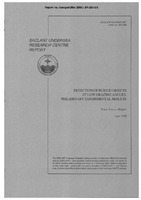| dc.contributor.author | Fox, Warren L. J. | |
| dc.contributor.author | Maguer, Alain | |
| dc.date.accessioned | 2018-10-11T14:08:46Z | |
| dc.date.available | 2018-10-11T14:08:46Z | |
| dc.date.issued | 1998/06 | |
| dc.identifier | 12133 | |
| dc.identifier.govdoc | SR-293 | |
| dc.identifier.uri | http://hdl.handle.net/20.500.12489/512 | |
| dc.description.abstract | This report considers the acoustic detection of objects buried in the seabed, and especially the possibility of using subcritical insonification geometries in order to increase coverage rate. | |
| dc.description.abstract | Experimental results are presented for acoustic transmissions in the approximate frequency range 2- | |
| dc.description.abstract | 16 kHz both above and below the nominal critical angle of the sediment. The buried objects studied | |
| dc.description.abstract | are a solid aluminum sphere of radius a, = 0.3 m and a 2 m long water-filled cylindrical steel shell with | |
| dc.description.abstract | radius a, = 0.25 m. Preliminary processing of the data has shown that gains in signal-to-noise ratio | |
| dc.description.abstract | can be obtained for subcritical cases by emphasizing the lower frequency components (in this case, f | |
| dc.description.abstract | < 3 kHz) where models predict that the target echo is strongest due to the evanescent nature of the | |
| dc.description.abstract | incident acoustic wave. | |
| dc.format | 47 p. : ill. ; 22 fig. | |
| dc.language | English | |
| dc.publisher | NATO. SACLANTCEN | |
| dc.relation.ispartofseries | ADB247388L | |
| dc.subject | Buried objects detection | |
| dc.title | Detection of buried objects at low grazing angles: preliminary experimental results | |
| dc.type | Scientific Report (SR) | |
